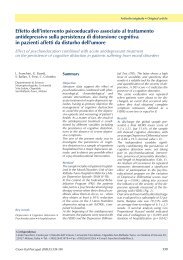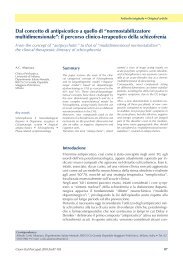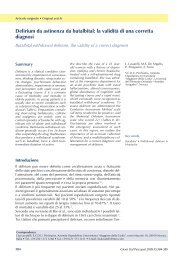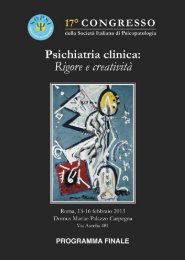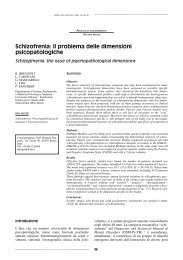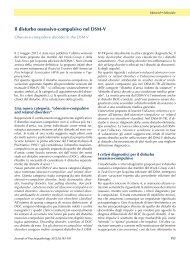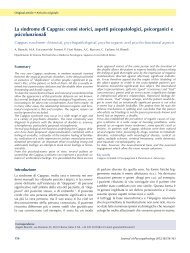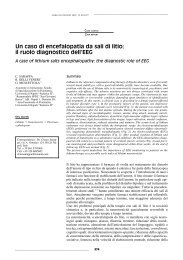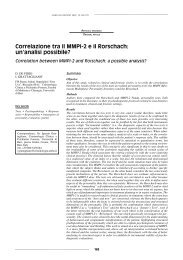XI Congresso della Società Italiana di Psicopatologia Psichiatria ...
XI Congresso della Società Italiana di Psicopatologia Psichiatria ...
XI Congresso della Società Italiana di Psicopatologia Psichiatria ...
Create successful ePaper yourself
Turn your PDF publications into a flip-book with our unique Google optimized e-Paper software.
POSTER<br />
The Assessments (Baseline; T1: end of the first week treatment;<br />
T2: end 4-week treatment; T3: end 8-week treatment;<br />
T4: end 12-week treatment; T5: end 18-week treatment; T6:<br />
end 24-week treatment) included besides the YMRS, Psychiatric<br />
Rating Scale (BPRS), the Hamilton Rating Scale for Depression<br />
(HAM-D+ atypical symptoms), the Clinical Global<br />
Impressions Scale for Bipolar Disorder, Mo<strong>di</strong>fied (CGI-BP-<br />
M), MADRS and the systematic report of adverse events.<br />
Amisulpride was added to other me<strong>di</strong>cations, but other antipsychotics.<br />
Results: 36 (88%) patients were responders, 4 (12%) were<br />
non responders.<br />
Amisulpride turned out to be effective and reasonably safe<br />
in the treatment of bipolar mania.<br />
At the end of the first week (T1)of treatment in responders<br />
(reduction of Young Mania Rating Scale > 50%); at endpoint<br />
24-week (T6) treatment amisulpride produced significant<br />
improvements(Total Score) on the YMRS (p = 0.002),<br />
the HAM-D+ atypical symptoms (p = 0.003), mania (p =<br />
0.002), and depression (p = 0.001) subscales of the CGI-BP-<br />
M, MADRS (p = 0.004).<br />
The following assessments confirmed the efficacy of this<br />
drug for manic bipolar.<br />
The most common side effect was sedation (N = 4; 12%),<br />
four females (no responders) galactorrhea, in responder’ s<br />
group some extrapyramidal symptoms and insomnia.<br />
Conclusions: amisulpride is a suitable drug for the treatment<br />
of Manic Bipolar, well tolerated and efficacious in the<br />
acute treatment of Bipolar Disorder I, manic phase.<br />
This study on amisulpride confirms that the drug, D(2) and<br />
D(3) antagonism, may be involved in the mechanisms of the<br />
therapeutic response to antipsychotics in mania.<br />
65. Effectiveness and tolerability<br />
of olanzapine in Bipolar Disorder I,<br />
treatment of bipolar mania: results of a 56week<br />
C. Cimmino, G. Foggia, I. Celentano, G. Barra, M. Romano,<br />
C. Ciliberti, A. Rocco, T. Cante, E. Mauro<br />
Psychiatry Emergency Hospital “San Giovanni <strong>di</strong> Dio”,<br />
Frattaminore, Napoli<br />
Background: the atypical agent olanzapine has demonstrated<br />
efficacy in bipolar mania in large randomized, controlled<br />
stu<strong>di</strong>es, and offers efficacy across a broader range of symptoms<br />
than typical antipsychotics.<br />
Olanzapine has been shown to be effective for manic<br />
episodes as monotherapy and in combination with other<br />
agents such as lithium and <strong>di</strong>valproex.<br />
Method: this was a clinical study involving 52 subjects suffering<br />
from Bipolar Disorder I, manic phase to a 56-week<br />
treatment with olanzapine (10 mg/day increased to 20 mg<br />
after 3 days of treatment).<br />
The sample of 22 females (F = 48%; mean age 29.3 ± 3.6.)<br />
and 30 males (M = 58%;mean age 32.2 ± 3.2) consecutively<br />
admitted in the Center for the study of Mood Disorders<br />
was recruited in Emergency Psychiatric Hospital with a<br />
DSM-IV TR <strong>di</strong>agnosis of Bipolar Disorder I, manic phase.<br />
The sample was assessed by Young Mania Rating Scale<br />
(YMRS) total score 20.<br />
The Assessments (Baseline; T1: end of the first week treatment;<br />
T2: end 4-week treatment; T3: end 8-week treatment;<br />
T4: end 12-week treatment; T5: end 18-week treatment; T6:<br />
end 24-week treatment; T7: end 36-week treatment; T8: end<br />
48-week treatment; T9: end 56-week treatment) included<br />
besides the YMRS, Psychiatric Rating Scale (BPRS), the<br />
Hamilton Rating Scale for Depression (HAM-D+ atypical<br />
symptoms), the Clinical Global Impressions Scale for Bipolar<br />
Disorder, Mo<strong>di</strong>fied (CGI-BP-M), MADRS and the systematic<br />
report of adverse events.<br />
Olanzapine was added to other me<strong>di</strong>cations, but other antipsychotics<br />
and other mood stabiliser.<br />
Results: 44 (85%) patients were responders in monotherapy,<br />
8 (15%) were non responders.<br />
Olanzapinés efficacy had been established in the treatment<br />
of bipolar mania.<br />
In this study has been observed effect of olanzapine on mania.<br />
At the end of the first week (T1) of treatment in responders<br />
(reduction of Young Mania Rating Scale > 75%); at endpoint<br />
24-week (T6) treatment olanzapine produced significant<br />
improvements (Total Score) on the YMRS (p = 0.001),<br />
the HAM-D+ atypical symptoms (p = 0.003), mania (p =<br />
0.001), and depression (p = 0.002) subscales of the CGI-BP-<br />
M, MADRS (p = 0.002); at endpoint 56-week (T9) treatment<br />
olanzapine produced significant data for antimanic effect<br />
or for hypomanic relapse absence at Young Mania Rating<br />
Scale (YMRS) total score ≤ 8.2 (p = 0.002), mania (p =<br />
0.001), and depression (p = 0.002) subscales of the CGI-BP-<br />
M, MADRS (p = 0.003)<br />
This study suggested that olanzapine was effective in preventing<br />
manic relapses<br />
(Patients 6, 11.5%). Relapse Data was not significantly in<br />
this sample.<br />
The most common side effect was weight gain (N = 8; 15%).<br />
Dropouts were eight males (no responders).<br />
Conclusions: olanzapine has proven efficacy in acute mania,<br />
some also in bipolar depression and in maintenance<br />
treatment.<br />
In this study there is firm evidence that olanzapine is effective<br />
than a mood stabiliser and tolerated and efficacious in<br />
the acute treatment of Bipolar Disorder I, manic phase.<br />
66. Quetiapine in the treatment<br />
of Personality Disorders (Cluster A and<br />
Cluster B and Cluster C)<br />
C. Cimmino, G. Foggia, I. Celentano, G. Barra, M. Romano<br />
Psychiatry Emergency Hospital, “San Giovanni <strong>di</strong> Dio”,<br />
Frattaminore, Napoli<br />
There are not many data in the literature regar<strong>di</strong>ng quetiapine<br />
use in Cluster A and Cluster B and Cluster C Personality<br />
Disorders.<br />
The objective of this study was to evaluate the efficacy and<br />
safety of quetiapine in treatment Personality Disorders.<br />
This analysis aimed to assess clinical response to quetiapine<br />
treatment in patients with Personality Disorder.<br />
Method: a total of 25 patients <strong>di</strong>agnosed with personality<br />
<strong>di</strong>sorders (9 patients, 36% Cluster A; 9 patients, 36% Cluster<br />
B; 7 patients, 28% Cluster C) accor<strong>di</strong>ng to DSM-IV TR cri-<br />
254




